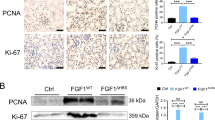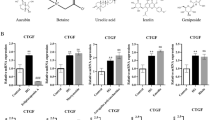Abstract
Fufang Xueshuantong Capsule (FXST) can reduce urinary albumin and whole blood viscosity in early diabetic nephropathy (DN) patients. This research aimed to investigate the effect of FXST on kidney function in DN rats and to identify the underlying molecular mechanisms. We performed Illumina RatRef-12 Expression BeadChip gene array analysis, and found that 3-month treatment with FXST significantly decreased 24-h urinary albumin, serum creatinine and blood urea nitrogen, and increased urinary creatinine in DN model rats. Kidney hypertrophy and glomerular mesangial matrix expansion were also ameliorated. Kidneys from the high-dose FXST group had 67 genes with significantly changed expression (34 increased, 33 decreased). DAVID analysis showed that the fold enrichment score of “collagen type 1” was the highest in all GO functional categories. DAVID function annotation cluster analysis indicated that the top annotation cluster included three GO function categories: “response to nutrient”, “response to nutrient levels” and “response to extracellular stimulus”. Based on KEGG pathway analysis, we found that the most two significant pathways were “metabolism of xenobiotics by cytochrome P450” and “drug metabolism”. Real-time PCR showed that relative levels of Col1a1 (collagen type 1 alpha 1), Ctgf (connective tissue growth factor) and Tgfb1 (transforming growth factor beta 1) were significantly decreased in the FXST group, while Cyp2c23 (cytochrome P-450 family 2 subfamily C polypeptide 23) and Nphs1 (nephrin) were increased. The increased expressions of TGFβ and collagen (type 1, α2) in the kidneys of DN rats were attenuated by FXST. Our data suggest that FXST can moderate kidney function in DN rats. The mechanism may involve the BMP2–TGFβ–CTGF pathway, CYP2C23 and podocyte proteins.






Similar content being viewed by others
References
Wild S, Roglic G, Green A, Sicree R, King H (2004) Global prevalence of diabetes: estimates for the year 2000 and projections for 2030. Diabetes Care 27:1047–1053
Wu AY, Kong NC, de Leon FA, Pan CY, Tai TY, Yeung VT, Yoo SJ, Rouillon A, Weir MR (2005) An alarmingly high prevalence of diabetic nephropathy in Asian type 2 diabetic patients: the MicroAlbuminuria Prevalence (MAP) Study. Diabetologia 48:17–26
Dalla Vestra M, Saller A, Bortoloso E, Mauer M, Fioretto P (2000) Structural involvement in type 1 and type 2 diabetic nephropathy. Diabetes Metab 26:8–14
National Institutes of Health, National Institute of Diabetes and Digestive and Kidney Diseases, Bethesda, MD (2010) US renal data systems: USRDS 2010 annual data report: atlas of end stage renal disease in the United States. http://www.usrds.org/2010/view/default.asp
Ritz E, Orth SR (1999) Nephropathy in patients with type 2 diabetes mellitus. N Engl J Med 341:1127–1133
White KE, Marshall SM, Bilous RW (2008) Prevalence of atubular glomeruli in type 2 diabetic patients with nephropathy. Nephrol Dial Transpl 23:3539–3545
Xing YW, Tang WJ, Zou JJ, Shi YQ (2010) Protective effect of compound Xueshuantong Capsule against damage of diabetic nephropathy in rat diabetic model. Acad J Second Mil Med Univ 30:1091–1094 (Chinese)
Lang J, Cao H, Wei A (1998) Comparative study on effect of Panax Notoginseng and Ticlid in treating early nephropathy. Zhongguo Zhong Xi Yi Jie He Za Zhi 18:727–729 (Chinese)
Sugano M, Yamato H, Hayashi T, Ochiai H, Kakuchi J, Goto S, Nishijima F, Lino N, Kazama JJ, Takeuchi T, Mokuda O, Ishikawa T, Okazaki R (2006) High-fat diet in low-dose-streptozotocin-treated heminephrectomized rats induces all features of human type 2 diabetic nephropathy: a new rat model of diabetic nephropathy. Nutr Metab Cardiovasc Dis 16:447–484
Huang JH, Huang XH, Chen ZY, Zheng QS, Sun RY (2004) Dose conversion among different animals and healthy volunteers in pharmacological study. Chin J Clin Pharmacol Ther 9:1069–1072
Border WA, Okuda S, Languino LR, Sporn MB, Ruoslahti E (1990) Suppression of experimental glomerulonephritis by antiserum against transforming growth factor β1. Nature 346:371–374
Eisen MB, Spellman PT, Brown PO, Botstein D (1998) Cluster analysis and display of genome-wide expression patterns. Proc Natl Acad Sci USA 95:14863–14868
Dennis G Jr, Sherman BT, Hosack DA, Yang J, Gao W, Lane HC, Lempicki RA (2003) DAVID: database for annotation, visualization, and integrated discovery. Genome Biol 4:P3
Hosack DA, Dennis G Jr, Sherman BT, Lane HC, Lempicki RA (2003) Identifying biological themes within lists of genes with EASE. Genome Biol 4:R70
Livak KJ, Schmittgen TD (2001) Analysis of relative gene expression data using real-time quantitative PCR and the 2(-Delta DeltaC(T)) method. Methods 25:402–408
Gross ML, EI-Shakmak A, Szabo A, Koch A, Kuhlmann A, Munter K, Ritz E, Amann K (2003) ACE-inhibitors but not endothelin receptor blockers prevent podocyte loss in early diabetic nephropathy. Diabetologia 46:856–868
Xuejiang W, Ichikawa H, Konishi T (2001) Antioxidant potential of qizhu tang, a Chinese herbal medicine, and the effect on cerebral oxidative damage after ischemia reperfusion in rats. Biol Pharm Bull 24:558–563
Wang L, Zhou GB, Liu P, Song JH, Liang Y, Yan XJ, Xu F, Wang BS, Mao JH, Shen ZX, Chen SJ, Chen Z (2008) Dissection of mechanisms of Chinese medicinal formula Realgar-Indigo naturalis as an effective treatment for promyelocytic leukemia. Proc Natl Acad Sci USA 105:4826–4831
Yang CY, Xie ZG, Cheng WB, Jiang X, Chen ZH (2009) Effects of Panax notogenseng saponins on anti-hyperglycemic, anti-obese and prevention from kidney pathological changes in KK-Ay mice. Zhong Yao Cai 32:1571–1576 (Chinese)
Chen ZH, Li J, Liu J, Zhao Y, Zhang P, Zhang MX, Zhang L (2008) Saponins isolated from the root of Panax notoginseng showed significant anti-diabetic effects in KK-Ay mice. Am J Chin Med 36:939–951
Sang Z, Zhou L, Fan X, McCrimmon RJ (2010) Radix astragali (huangqi) as a treatment for defective hypoglycemia counterregulation in diabetes. Am J Chin Med 38:1027–1038
Luo P, Tan Z, Zhang Z, Li H, Mo Z (2008) Inhibitory effects of salvianolic acid B on the high glucose-induced mesangial proliferation via NF-kappaB-dependent pathway. Bio Pharm Bull 31:1381–1386
Dalla Vestra M, Masiero A, Roiter AM, Saller A, Crepaldi G, Fioretto P (2003) Is podocyte injury relevant in diabetic nephropathy? Studies in patients with type 2 diabetes. Diabetes 52:1031–1035
Doublier S, Salvidio G, Lupia E, Ruotsalainen V, Verzola D, Deferrari G, Camussi G (2003) Nephrin expression is reduced in human diabetic nephropathy, evidence for a distinct role for glycated albumin and angiotensin II. Diabetes 52:1023–1030
Vleming LJ, Baelde JJ, Westendorp RW, Daha MR, van Es LA, Bruijn JA (1997) The glomerular deposition of PAS positive material correlates with renal function in human kidney diseases. Clin Nephrol 47:158–167
Sharma K, Jin Y, Guo J, Ziyadeh FN (1996) Neutralization of TGF-beta by anti-TGF-beta antibody attenuates kidney hypertrophy and the enhanced extracellular matrix gene expression in STZ-induced diabetic mice. Diabetes 45:522–530
Shi Y, Massague J (2003) Mechanisms of TGF-beta signaling from cell membrane to the nucleus. Cell 113:685–700
Nett PC, Ortmann J, Celeiro J, Haas E, Hofmann-Lehmann R, Tornillo L, Terraciano LM, Barton M (2006) Transcriptional regulation of vascular bone morphogenetic protein by endothelin receptors in early autoimmune diabetes mellitus. Life Sci 78:2213–2218
Stelnicki EJ, LongakerMT HolmesD, Vanderwall K, Largman C, Harrison MR, Hoffman WY (1998) Bone morphogenetic protein-2 induces scar formation and skin maturation in the second trimester fetus. Plast Reconstr Surg 101:12–19
Faler BJ, Macsata RA, Plummer D, Mishra L, Sidawy AN (2006) Transforming growth factor-beta and wound healing. Perspect Vasc Surg Endovasc Ther 18:55–62
Hocevar BA, Howe PH (2000) Analysis of TGF-beta-mediated synthesis of extracellular matrix components. Methods Mol Biol 142:55–65
Sharma K, Ziyadeh FN (1995) Hyperglycemia and diabetic kidney disease: the case for transforming growth factor-b as a key mediator. Diabetes 44:1139–1146
Ziyadeh FN, Hoffman BB, Han DC, Iqlesias-De La Crus MC, Hong SW, Isono M, Chen S, McGowan TA, Sharma K (2000) Long-term prevention of renal insufficiency, excess matrix gene expression, and glomerular mesangial matrix expansion by treatment with monoclonal antitransforming growth factor-beta antibody in db/db diabetic mice. Proc Natl Acad Sci USA 97:8015–8020
Ito Y, Goldschmeding YR, Bende RJ, Claessen N, Chand M, Kleii L, Rabelink T, Weening J, Aten J (2001) Kinetics of connective tissue growth factor expression during experimental proliferative glomerulonephritis. J Am Soc Nephrol 12:472–484
Sinal CJ, Miyata M, Tohkin M, Nagata K, Bend JR, Gonzalez FJ (2000) Targeted disruption of soluble epoxide hydrolase reveals a role in blood pressure regulation. J Biol Chem 275:40504–40510
Wang MH (2006) Renal cytochrome P450-derived eicosanoids and hypertension. Curr Hyperten Rev 2:227–236
Natarajan R, Reddy MA (2003) HETEs/EETs in renal glomerular and epithelial cell functions. Curr Opin Pharmacol 3:198–203
Acknowledgments
This work was funded by Grants from the foundation of Peking Union Medical College Hospital (No. 2006119). Thanks go to Prof. Yuli Ling for elaborate work in pathology.
Conflict of interest
There is no conflict of interest to disclose.
Author information
Authors and Affiliations
Corresponding author
Electronic supplementary material
Below is the link to the electronic supplementary material.
Rights and permissions
About this article
Cite this article
Zhang, Q., Xiao, X., Li, M. et al. Attenuating effect of Fufang Xueshuantong Capsule on kidney function in diabetic nephropathy model. J Nat Med 67, 86–97 (2013). https://doi.org/10.1007/s11418-012-0654-y
Received:
Accepted:
Published:
Issue Date:
DOI: https://doi.org/10.1007/s11418-012-0654-y




